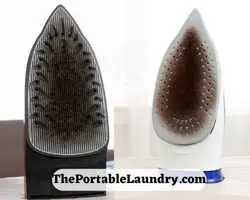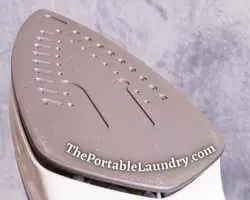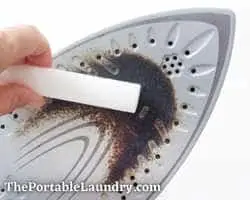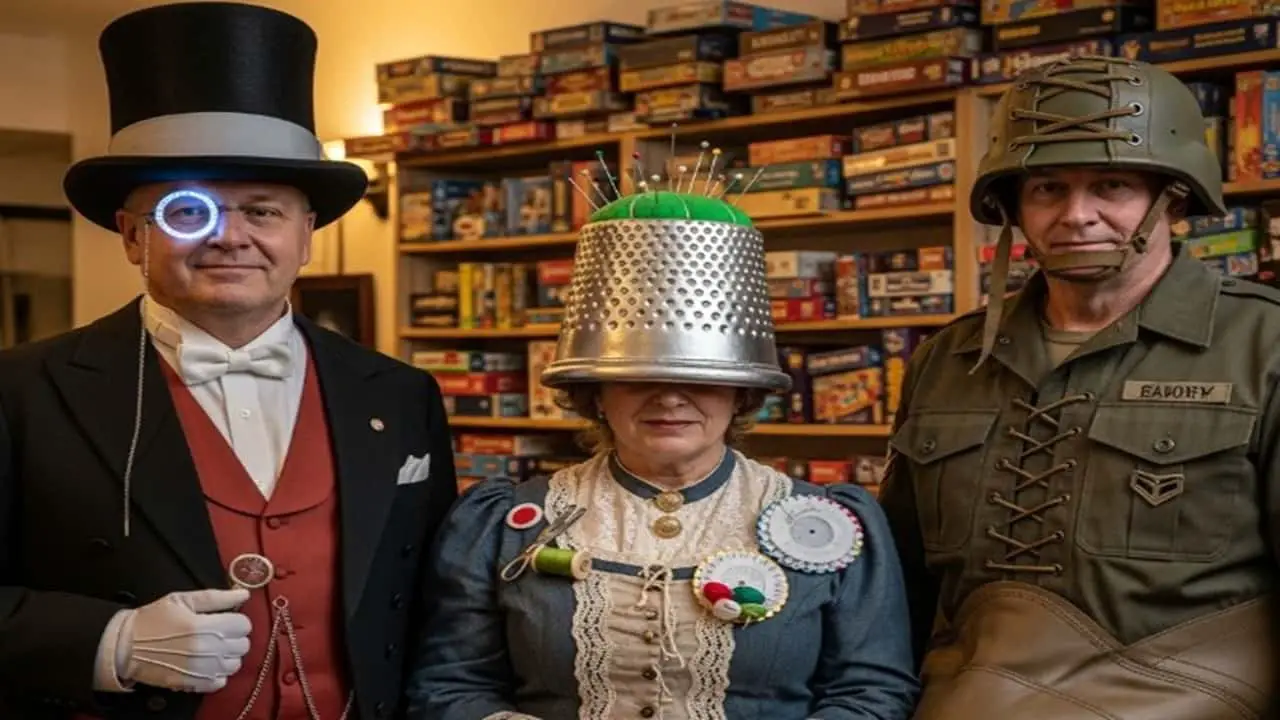In order to clean the soleplate of an iron, start by wiping the soleplate’s surface with a clean, dry cloth to discharge excess dirt and grime. Next, dip the soft cloth in soapy water and scrub the affected area for a few minutes. Finally, wipe it with a dry cloth, and if required, repeat the above steps.
For stains or buildups that are hard to get rid of, you will need an abrasive cleaner. Apply an abrasive cleaner over the surface using a soft brush, and scrub the area for a couple of minutes. Finally, leave the application to settle for about 10 to 15 minutes and wipe it thoroughly with a damp cloth.
Key Takeaways
- Irons are not everyday appliances for many and most people rely on laundromats for ironing even after owning one at home.
- Wiping the iron’s surface such as the soleplate after every use is always advised to prevent buildups.
- Dirty soleplates or soleplates that have become black can easily pass on the dirt to your clothes, spoiling them in the process.
- Cleaning the iron’s soleplate is easy and can be done by simply using a clean, soft cloth, water, vinegar, or an abrasive cleaner.
Why should you clean the iron’s soleplate?
Cleaning the iron’s bottom surface regularly is always a good practice.
You should pay attention to the soleplates that deal with a variety of fabrics, causing them to become dirtier and more difficult to clean.
If your soleplates are dirty, you are more likely to get dirt on your clothes, which will make them look dull and discolored.
Here are a few reasons why you should clean the iron’s soleplate in the first place.
Build-up and burns
Over time, soleplates can become dirty due to the melted fabric particles and residue from your clothing.
A film can form on the soleplate surfaces when fabric fibers, lint, dust, and even burned starch or fabric decorations build up.
The soleplates usually turn brown or black due to buildups and melted fibers that get stuck to the surface from overuse.
It usually looks something like this (refer to the image below):

This can happen even if you use a protective garment such as a pressing cloth.
In most iron soleplates, you will find small ridges and patterns that become an easy target for such buildups.
If you let this buildup go for a long time without taking care of it, it gets hard to clean.
You can refer to the below image, which includes small ridges and patterns over the surface of the soleplate.

Rusting
There is always a possibility that iron soleplates can rust over time.
Rusting is not a good indicator for irons or fabrics, especially when using steam irons.
Thus, you should clear any rust-causing residues as soon as you notice them on the iron’s surface.
Most often, if you leave water in the reservoir or the iron’s dedicated tank, it will start producing rusty spots, especially on the soleplates.
If you do not remove rust from the iron’s surface at the initial phase, it will keep on increasing, and over time it will deteriorate.
Lastly, make sure to empty the water from the iron after every use.
How to clean an iron soleplate effectively?
To clean the iron’s soleplate, make sure it is unplugged from the power source and completely cool.
By all means, this should be done as a safety precaution to prevent potential shocks.
Now, you can start by wiping the bottom surface (soleplate) of the iron with a clean cloth.
The next step is to dip a cloth or sponge, or wet a portion in soapy water, and start rubbing over the affected surface.
You can use a toothbrush to scrub away the residues, as it will be easier to deal with the ridges and tiny holes of the soleplate with a toothbrush.
As a home remedy, you can also use distilled vinegar to clean the affected parts of the soleplate where residue has built up.
To do this, simply wet or dip a portion of clean cloth in the vinegar solution and start applying it over the stained surface evenly.
Then, let this cleaning solution sit on the soleplates for some time.
The acidic properties of vinegar will help break down the buildup-causing residues.
Finally, you can wipe the surface thoroughly with a clean, dry cloth.
As the last step, wipe the surface with a damp cloth and let it dry.
You may have to repeat the above steps if the stains or buildups do not disappear at once.
If your iron has built up a lot of residues, you may need to use a scraper or brush to remove it.

First, use a soft cloth or sponge to wipe away any dirt or grime from the soleplate before proceeding to the next step.
Start by brushing or scraping the surface carefully to clear the stubborn buildups from the surface of the iron soleplate.
Be careful not to scratch the surface of the soleplate while you scrape or brush away the residue.
You can find special scrapers and brushes designed for this purpose at most hardware stores.
Once you’ve removed all the dirt and grime from your iron’s soleplate, be sure to wipe it dry with a clean cloth before using your iron again.
Alternatively, you can try using a mild abrasive cleaner.
Be sure to wipe the soleplate afterward with a damp cloth to remove any residue.
Alternate ways to clean the Iron soleplates
There are several alternate ways to clean the iron soleplate effectively.
Here are some of the popular hacks to get rid of stains and burnt marks from the iron soleplate.
Newspaper
The rough texture of the newspaper can help scrub away tough dirt and residues without hurting the soleplate.
Simply put the iron on its hottest setting and scrub the iron’s soleplate using a newspaper.
While doing so, make sure to wear safety gloves or oven mitts in order to protect your hands.
Using Tylenol
If you have any burned residue on your iron, one way to remove it is to use Tylenol.
Just turn the iron on to its highest setting, and while it’s hot, press the pill into the center of the burn mark.
The intense heat from the iron’s soleplate will melt the pill and turn it into a gel that removes the tough spots.
Lastly, wipe down the soleplate with a damp cloth or paper towel until it’s completely clean.
Note: You may need to repeat this process a few times if there are multiple marks.
Baking Soda and Water
To clean your iron with baking soda, mix the soda with water to create a paste.
Next, use a soft brush or towel to scrub the paste off the iron’s soleplate.
Then, wipe the residue away with water and make sure the paste is completely gone.
Vinegar Solution
To clean the iron plate with vinegar, soak a towel or thick, soft cloth in vinegar and put the iron on top of the cloth or towel with the soleplate facing down.
Let the iron sit like this for 30 minutes, and then wipe it off.
This should help you get rid of the burn mark or black spots on the soleplate.
Nail Polish remover
Nail polish remover contains acetone, which is a strong solvent that can help break down the dried-on residue on an iron’s soleplate.
To use nail polish remover to clean your iron, simply soak a cloth or sponge in the remover and wipe down the surface of the soleplate.
Be sure to rinse the soleplate with water after wiping off the residue and dry it completely before using your iron again.
While doing so, be careful not to get any of the nail polish removers on your skin, as they may be harmful.
Dishwasher Soap
Using dishwasher soap is a great way to clean your iron’s soleplate because it contains powerful detergents that help break down the tough buildups.
In order to use dishwasher soap to clean the iron soleplate, simply add a few drops of the soap to a bowl of water and stir.
Then, using a soft cloth or sponge, scrub the soleplate with soapy water.
Lastly, don’t forget to wash off the soleplate with clean water and then dry it.
Toothpaste Formula
To use toothpaste to clean an iron’s soleplate, add some toothpaste directly to the soleplate and scrub it using a soft sponge or brush.
Let the toothpaste settle for about 2 to 3 minutes.
The abrasive nature of the toothpaste will help remove any burnt or stuck-on residue from the iron’s soleplate.
Finally, wipe off the toothpaste residue with a clean and damp cloth.
Final Thoughts
Wiping the iron’s bottom surface after every use is always a good practice, as it prevents unwanted buildups over time.
The soleplate can become dirty from a build-up of fabric fibers, lint, dust, and even burned-on starch or fabric decorations that usually require instant cleaning.
A dirty soleplate is not only ugly, but it can also make your iron less effective and cause unexpected damage to your clothes.
Lastly, to clean the ridges on the soleplate well, it’s recommended to use a toothbrush or a brush with soft bristles and the right cleaner.
Frequently Asked Questions
Why is my iron’s bottom looking black?
The fibers of your garment happen to melt due to excess heat, which sticks to the bottom surface, making it look brownish or black. This usually happens when you use the iron with the wrong settings or leave it on a certain part of the garment for a long time.
How do I remove rust from iron?
You should try to wipe or scrub out the rust as much as possible using a cloth dampened with soap and water. If the rusting is bad, you can just buy a rust remover that works for the type of metal used for the soleplate.
How to clean an iron with paracetamol?
Set your iron to the highest setting, take a paracetamol tablet with tweezers, and rub the tablet all over the soleplate. Next, wipe off the tablet residue with a damp cloth. This method is suitable for lightly soiled soleplates only and should not be used on heavily soiled ones.
You May Also Like
- How to clean dirty Collars and cuffs?
- How To Clean Car Carpet Without Extractor? (Comprehensive)
- How to Clean a Top Load Washing Machine? (Ultimate Guide)
- How to clean the washing machine filter top loader?
- How to clean Amana washing machine filter top loader? (Step by Step)
- How to Clean Kenmore Washing Machine Filter Top Loader? (The Easy Way)
- How to Clean Portable Washing Machine? (Comprehensive guide)
- How do you clean the washing machine agitator?
- How to remove Grass Stains from clothes? (Easy Way)





